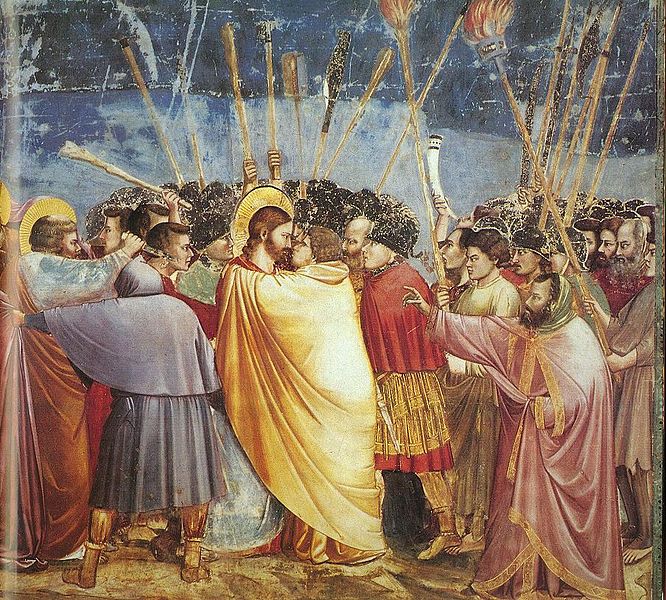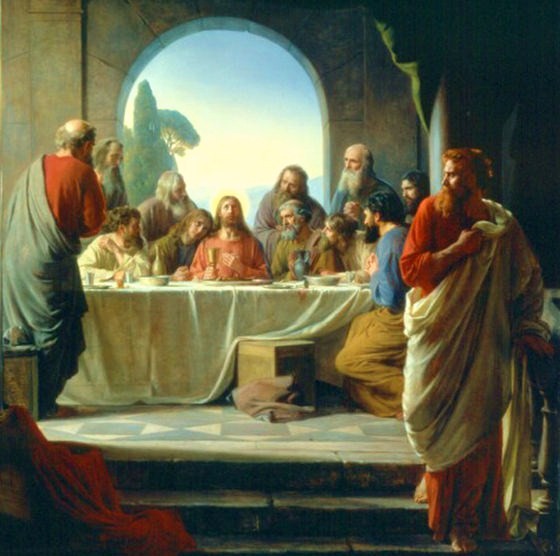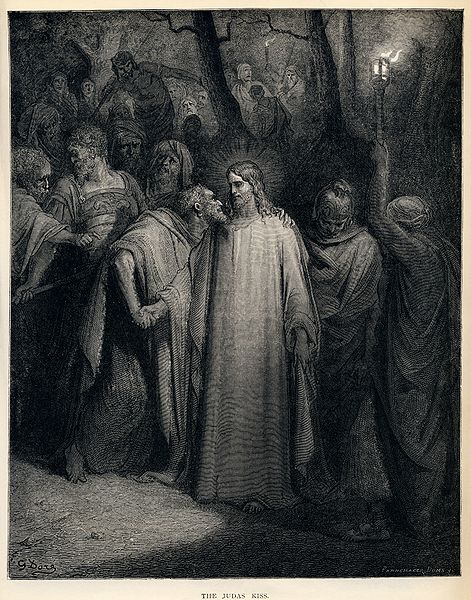<Back to Index>
- Apostle Judas Iscariot, 1st
Century
PAGE SPONSOR


Judas Iscariot (Hebrew: יהודה איש־קריות, Yehuda, Yəhûḏāh ʾΚ-qrayyôṯ) was, according to the New Testament, one of the Twelve Apostles of Jesus Christ.
He is infamously known for his kiss and betrayal of Jesus to the hands of the chief Sanhedrin priests in exchange for a payment of thirty pieces of silver coins. His place among the Twelve Apostles was later replaced by Matthias.
His name is sometimes used to accuse someone of betrayal,
and is oftentimes confused with Saint
Jude Thaddeus.
In the Greek New Testament, Judas is called Ιούδας Ισκάριωθ and Ισκαριώτης . "Judas" (spelled "Ioudas" in ancient Greek and "Iudas" in Latin, pronounced yudas in both) is the Greek form of the common name Judah (יהודה, Yehûdâh, Hebrew for "God is praised"). The Greek spelling underlies other names in the New Testament that are traditionally rendered differently in English: Judah and Jude.
The significance of "Iscariot" is uncertain. There are several major theories on etymology:
- One popular explanation derives Iscariot from Hebrew איש־קריות, Κ-Qrîyôth, or "man of Kerioth". The Gospel of John refers to Judas as "son of Simon Iscariot" (although the biblical text only refers to him as "the son of Simon" (Jn 6:71, Jn 13:26, King James Version)), implying it was not Judas, but his father, who came from there. Some speculate that Kerioth refers to a region in Judea, but it is also the name of two known Judean towns.
- A second theory is that "Iscariot" identifies Judas as a member of the sicarii. These were a cadre of assassins among Jewish rebels intent on driving the Romans out of Judea. However, some historians maintain the sicarii arose in the 40s or 50s of the 1st century, in which case Judas could not have been a member.
- A third possibility advanced by Ernst Wilhelm Hengstenberg is that Iscariot means "the liar" or "the false one," perhaps from the Hebrew אִשְׁקַרְיָא.
- Fourth, some have proposed that the word derives from an Aramaic word meaning "red color," from the root סקר.
- Fifth, the word derives from one of the Aramaic roots סכר or סגר. This would mean "to deliver," based on the LXX rendering of Isaiah 19:4a — a theory advanced by J. Alfred Morin.
- Finally, the epithet could be associated with the manner of Judas' death, i.e., hanging. This would mean Iscariot derives from a kind of Greek - Aramaic hybrid: אִסְכַּרְיוּתָא, Iskarioutha, "chokiness" or "constriction." This might indicate that the epithet be applied posthumously by the remaining disciples, but Joan E. Taylor has argued that it was a descriptive name given to Judas by Jesus, since other disciples such as Simon Peter / Cephas (Kephas = "rock") were also given such names.
Judas is mentioned in the synoptic gospels, the Gospel of John and at the beginning of Acts of the Apostles.
Mark states that the chief priests were looking for a sly way to arrest Jesus. They decided not to do so during the feast since they were afraid that people would riot; instead, they chose the night before the feast to arrest him. In the Gospel of Luke, Satan enters Judas at this time.
According to the account in the Gospel of John, Judas
carried the disciples' money bag. He betrayed Jesus
for a bribe of "thirty pieces of silver"
by identifying him with a kiss — "the kiss of Judas" — to
arresting soldiers of the High Priest Caiaphas, who then
turned Jesus over to Pontius Pilate's soldiers.
There are a few descriptions of the death of Judas, two of which are included in the modern Biblical canon:
- Matthew 27:3-10 says that Judas returned the money to the priests and committed suicide by hanging himself. They used it to buy the potter's field. The Gospel account presents this as a fulfillment of prophecy.
- The Acts of the Apostles says that Judas used the money to buy a field, but fell headfirst, and burst asunder in the midst, and all his bowels gushed out. This field is called Akeldama or Field of Blood.
- The non - canonical Gospel of Judas says Judas had a vision of the disciples stoning and persecuting him.
- Another account was preserved by the early Christian leader, Papias: "Judas walked about in this world a sad example of impiety; for his body having swollen to such an extent that he could not pass where a chariot could pass easily, he was crushed by the chariot, so that his bowels gushed out."
The existence of conflicting accounts of the death of Judas has caused problems for scholars who have seen them as threatening the reliability of Scripture. This problem was one of the points causing C. S. Lewis, for example, to reject the view "that every statement in Scripture must be historical truth". Various attempts at harmonization have been suggested, such as that of Augustine that Judas hanged himself in the field, and the rope eventually snapped and the fall burst his body open, or that the accounts of Acts and Matthew refer to two different transactions.
Modern scholars tend to reject these approaches stating that the Matthew account is a midrashic exposition that allows the author to present the event as a fulfillment of prophetic passages from the Old Testament. They argue that the author adds imaginative details such as the thirty pieces of silver, and the fact that Judas hangs himself, to an earlier tradition about Judas' death.
Matthew's description of the death as fulfillment of a
prophecy "spoken through Jeremiah the prophet" caused
controversy, since there is no such reference in Jeremiah;
instead, it seems to refer to a story from the Book of
Zechariah
which refers to the return of a payment of thirty pieces
of silver. Some writers, such as Jerome and John Calvin
concluded that this was an obvious error. Some modern
writers suggest that the Gospel writer may have had a
passage from Jeremiah in mind, such as chapters 18:1-4
and 19:1-13
which refers to a potter's jar and a burial place, and
chapter 32:6-15 which refers to a burial
place and an earthenware jar. Randel Helms
wrote, " That Matthew 27v9 thinks the passage he is
quoting comes from Jeremiah shows that he has departed
from his usual practice - especially when using Mark - of
checking the accuracy of his source's Old Testament
reference. Matthew's source has blended Jeremiah's buying
of a field and placing the deed in a pot with Zechariah's
casting of thirty pieces of silver down in the temple and
the purchase of the Potter's Field. The story of Judas's
actions after the betrayal is one of the most revealing
examples of the early Christians' fictional and
imaginative use of the Old Testament as a book about
Jesus. "
There are several explanations as to why Judas betrayed Jesus. A prevalent explanation is that Judas betrayed Jesus for 30 pieces of silver (Matthew 26:14-16). One of Judas's main weaknesses seemed to be money (John 12:4-6). A possibility is that Judas expected Jesus to overthrow Roman rule of Israel. In this view, Judas is a disillusioned disciple betraying Jesus not so much because he loved money, but because he loved his country and thought Jesus had failed it. According to Luke 22:3-6 and John 13:27, Satan entered into him and called him to do it.
The Gospels suggest that Jesus foresaw (John 6:64, Matthew 26:25) and allowed Judas's betrayal (John 13:27-28). One explanation is that Jesus allowed the betrayal because it would allow God's plan to be fulfilled. Another is that regardless of the betrayal, Jesus was ultimately destined for crucifixion. In April 2006, a Coptic papyrus manuscript titled the Gospel of Judas from 200 AD was translated, suggesting that Jesus told Judas to betray him, although some scholars question the translation.
Origen knew of a tradition according to which the greater circle of disciples betrayed Jesus, but does not attribute this to Judas in particular, and Origen did not deem Judas to be thoroughly corrupt (Matt., tract. xxxv).
Judas is the subject of philosophical writings, including The Problem of Natural Evil by Bertrand Russell and "Three Versions of Judas", a short story by Jorge Luis Borges. They allege various problematic ideological contradictions with the discrepancy between Judas's actions and his eternal punishment. John S. Feinberg argues that if Jesus foresees Judas's betrayal, then the betrayal is not an act of free will, and therefore should not be punishable. Conversely, it is argued that just because the betrayal was foretold, it does not prevent Judas from exercising his own free will in this matter. Other scholars argue that Judas acted in obedience to God's will. The gospels suggest that Judas is apparently bound up with the fulfillment of God's purposes (John 13:18, John 17:12, Matthew 26:23-25, Luke 22:21-22, Matt 27:9-10, Acts 1:16, Acts 1:20), yet woe is upon him, and he would have been better unborn (Matthew 26:23-25). The difficulty inherent in the saying is its paradoxicality: if Judas had not been born, the Son of Man will apparently no longer go "as it is written of him." The consequence of this apologetic approach is that Judas's actions come to be seen as necessary and unavoidable, yet leading to condemnation.
Erasmus believed that Judas was free to change his intention, but Martin Luther argued in rebuttal that Judas's will was immutable. John Calvin states that Judas was predestined to damnation, but writes on the question of Judas's guilt: "surely in Judas' betrayal, it will be no more right, because God himself willed that his son be delivered up and delivered him up to death, to ascribe the guilt of the crime to God than to transfer the credit for redemption to Judas."
It is speculated that Judas's damnation, which seems
possible from the Gospels' text, may not stem from his
betrayal of Christ, but from the despair which caused him
to subsequently commit suicide. This position is
not without its problems since Judas was already damned by
Jesus even before he committed suicide (see John 17:12), but it does
avoid the paradox of Judas's predestined act setting in
motion both the salvation of all mankind and his own
damnation. The damnation of Judas is not a universal
conclusion, and some have argued that there is no
indication that Judas was condemned with eternal
punishment. Others argue Judas had the free will to accept
or reject Christ anytime before his death.
Adam Clarke writes: "he [Judas] committed a heinous act
of sin...but he repented (Matthew
27:3-5) and did what he could to undo his
wicked act: he had committed the sin unto death, i.e. a
sin that involves the death of the body; but who can
say, (if mercy was offered to Christ's murderers? (Luke 23:34)...) that the
same mercy could not be extended to wretched Judas?..."
Most Christians still consider Judas a traitor. Indeed the term Judas has entered many languages as a synonym for betrayer.
American philosopher Will Durant argues that the early Church would never create material that only embarrassed the followers of Jesus, or weakened its position with opponents (in this case, a traitor apostle).
Some have embraced the alternative notion that Judas was merely the negotiator in a prearranged prisoner exchange (following the money changer riot in the Temple) that gave Jesus to the Roman authorities by mutual agreement, and that Judas's later portrayal as "traitor" was a historical distortion.
In his book The Passover Plot the British theologian Hugh J. Schonfield argues that the crucifixion of Christ was a conscious re-enactment of Biblical prophecy and Judas acted with Jesus' full knowledge and consent in "betraying" his master to the authorities.
Theologian Aaron Saari contends in his work The Many Deaths of Judas Iscariot that Judas Iscariot was the literary invention of the Markan community. As Judas does not appear in the Epistles of Paul, nor in the Q Gospel, Saari argues that the language indicates a split between Pauline Christians, who saw no reason for the establishment of an organized Church, and the followers of Peter. Saari contends that the denigration of Judas in Matthew and Luke-Acts has a direct correlation to the elevation of Peter.
Further evidence of the absence of the Judas story in the earliest Christian documents is drawn on the basis of Matthew 19:28 and Luke 22:28-30. Here Jesus tells his disciples that they will “sit on the twelve thrones judging the twelve tribes of Israel.” No exception is made for Judas even though Jesus was aware of his impending act of betrayal. The answer may lie in the fact that the source of these verses could be the hypothetical Q document (QS 62). Q is thought to predate the gospels and would be one of the earliest Christian documents. Given that possibility, the betrayal story could have been invented by the writer of Mark. The book The Sins of the Scripture, by John Shelby Spong, investigates the possibility that early Christians compiled the Judas story from three Old Testament Jewish betrayal stories. He writes, "...the act of betrayal by a member of the twelve disciples is not found in the earliest Christian writings. Judas is first placed into the Christian story by the Gospel of Mark (3:19), who wrote in the early years of the eighth decade of the Common Era." He points out that some of the Gospels, after the Crucifixion, refer to the number of Disciples as "Twelve", as if Judas were still among them. He compares the three conflicting descriptions of Judas's death — hanging, leaping into a pit, and disemboweling — with three Old Testament betrayals followed by similar suicides.
Spong's conclusion is that early Bible authors, after the First Jewish - Roman War, sought to distance themselves from Rome's enemies. They augmented the Gospels with a story of a disciple, personified in Judas as the Jewish state, who either betrayed or handed over Jesus to his Roman crucifiers. Spong identifies this augmentation with the origin of modern Anti - Semitism.
Jewish scholar Hyam Maccoby, suggests that in the New Testament, the name "Judas" was constructed as an attack on the Judaeans or on the Judaean religious establishment held responsible for executing Christ. The English word "Jew" is derived from the Latin Iudaeus, which, like the Greek Ιουδαίος (Ioudaios), could also mean "Judaean".
Judas has been a figure of great interest to esoteric
groups, such as many Gnostic
sects. Irenaeus records the beliefs of one Gnostic sect,
the Cainites, who
believed that Judas was an instrument of the Sophia,
Divine Wisdom, thus earning the hatred of the Demiurge. In
the Hebrew Bible, the book of Zechariah, the one who casts
thirty pieces of silver, as Judas does in the Gospels, is
a servant of God. His betrayal of Jesus thus was a victory
over the materialist world. The Cainites later split into
two groups, disagreeing over the ultimate significance of
Jesus in their cosmology.
During the 1970s, a Coptic papyrus codex (book) was discovered near Beni Masah, Egypt which appeared to be a 3rd - or 4th century - AD copy of a 2nd century original, describing the story of Jesus's death from the viewpoint of Judas. At its conclusion, the text identifies itself as "the Gospel of Judas" (Euangelion Ioudas).
The discovery was given dramatic international exposure in April 2006 when the US National Geographic magazine (for its May edition) published a feature article entitled The Gospel of Judas with images of the fragile codex and analytical commentary by relevant experts and interested observers (but not a comprehensive translation). The article's introduction stated: "An ancient text lost for 1,700 years says Christ's betrayer was his truest disciple". The article points to some evidence that the original document was extant in the 2nd century: "Around A.D. 180, Irenaeus, Bishop of Lyon in what was then Roman Gaul, wrote a massive treatise called Against Heresies [in which he attacked] a 'fictitious history,' which 'they style the Gospel of Judas.'"
Before the magazine's edition was circulated, other news media gave exposure to the story, abridging and selectively reporting it.
In December 2007, a New York Times op-ed article by April DeConick asserted that the National Geographic's translation is badly flawed: For example, in one instance the National Geographic transcription refers to Judas as a "daimon", which the society’s experts have translated as "spirit". However, the universally accepted word for "spirit" is "pneuma" — in Gnostic literature "daimon" is always taken to mean "demon". The National Geographic Society responded that "Virtually all issues April D. DeConick raises about translation choices are addressed in footnotes in both the popular and critical editions". In a later review of the issues and relevant publications, critic Joan Acocella questioned whether ulterior intentions had not begun to supersede historical analysis, e.g., whether publication of The Gospel of Judas could be an attempt to roll back ancient anti - semitic imputations. She concluded that the ongoing clash between scriptural fundamentalism and attempts at revision were childish because of the unreliability of the sources. Therefore, she argued, "People interpret, and cheat. The answer is not to fix the Bible but to fix ourselves." Other scholars have questioned the initial translation and interpretation of the Gospel of Judas by the National Geographic team of experts.
According to medieval copies (the earliest copies
from the 15th century) of the Gospel of Barnabas it was
Judas, not Jesus, who was crucified on the cross. This
work states that Judas's appearance was transformed to
that of Jesus', when the former, out of betrayal, led the
Roman soldiers to arrest Jesus who by then was ascended to
the heavens. This transformation of appearance was so
identical that the masses, followers of Christ, and even
the Mother of Jesus, Mary, initially thought that the one
arrested and crucified was Jesus himself. The gospel then
mentions that after three days since burial, Judas's body
was stolen from his grave, and then the rumors spread of
Jesus being risen from the dead. When Jesus was informed
in the third heaven about what happened, he prayed to God
to be sent back to the earth, and descended and gathered
his mother, disciples, and followers, and told them the
truth of what happened. He then ascended back to the
heavens, and will come back at the end of times as a just
king.
The term Judas has entered many languages as a synonym for betrayer, and Judas has become the archetype of the traitor in Western art and literature. Judas is given some role in virtually all literature telling the Passion story, and appears in a number of modern novels and movies.
In the Eastern Orthodox hymns of Holy Wednesday (the Wednesday before Pascha), Judas is contrasted with the woman who anointed Jesus with expensive perfume and washed his feet with her tears. According to the Gospel of John, Judas protested at this apparent extravagance, suggesting that the money spent on it should have been given to the poor. After this, Judas went to the chief priests and offered to betray Jesus for money. The hymns of Holy Wednesday contrast these two figures, encouraging believers to avoid the example of the fallen disciple and instead to imitate Mary's example of repentance. Also, Wednesday is observed as a day of fasting from meat, dairy products, and olive oil throughout the year in memory of the betrayal of Judas. The prayers of preparation for receiving the Eucharist also make mention of Judas's betrayal: "I will not reveal your mysteries to your enemies, neither like Judas will I betray you with a kiss, but like the thief on the cross I will confess you."
Judas Iscariot is often represented with red hair in Spanish culture
and by William Shakespeare. The practice is comparable to
the Renaissance portrayal of Jews with red hair, which was
then regarded as a negative trait and which may have been
used to correlate Judas Iscariot with contemporary Jews.
Judas has become the archetype of the betrayer in Western
culture, with some role in virtually all literature
telling the Passion story.
- In Dante's Inferno, he is condemned to the lowest circle of Hell, the Ninth Circle for Traitors, also known as Cocytus, where he is one of three sinners deemed evil enough that they are doomed to be chewed for eternity in the mouths of the triple - headed Satan (the others being Brutus and Cassius, the assassins of Julius Caesar).
- In art, one of the most famous depictions of Judas
Iscariot and his kiss of betrayal of Jesus is The Taking
of Christ by Italian Baroque artist, Caravaggio, done in
1602.
- In Memoirs of Judas (1867) by Ferdinando
Petruccelli della Gattina, he is seen as a leader of the
Jewish revolt against the rule of Romans.
- Edward Elgar's oratorio, The Apostles, depicts
Judas as wanting to force Jesus to declare his divinity
and establish the kingdom on earth.
- In Mikhail Bulgakov's novel The Master and
Margarita, Judas is paid by the high priest of
Judaea to testify against Jesus, who had been inciting
trouble among the people of Jerusalem. After authorizing
the crucifixion, Pilate suffers an agony of regret and
turns his anger on Judas, ordering him assassinated. The
story - within - a - story appears as a counter -
revolutionary novel in the context of Moscow in the
1920s - 1930s.
- Tres versiones de Judas (English title: '"Three Versions of Judas"') is a short story by Argentine writer and poet Jorge Luis Borges. It was included in Borges' anthology, Ficciones, published in 1944, and revolves around the main character's doubts about the canonical story of Judas who instead creates three alternative versions.

